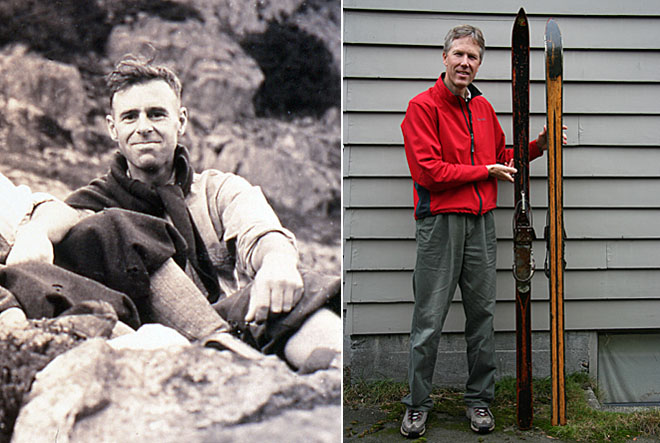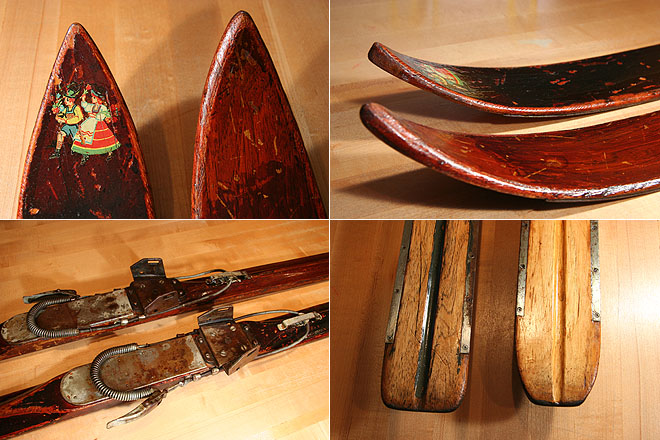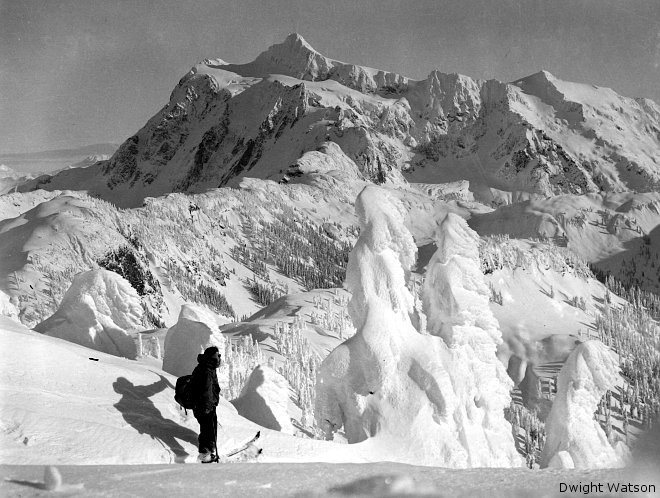

|
| Left: Dwight Alvin Watson, circa 1939. Right: The author with the only known pair of Watson's skis in 2007. |
|
Dwight Watson,
born December 22, 1900, can justifiably be called the father of
backcountry skiing in Washington state. From the mid-1930s through
mid-1940s, Watson and a small group of friends explored many areas of
the Cascade and Olympic Mountains that had never been skied before.
Watson's first ski ascents in the Cascades include Ruth Mountain, Glacier Peak, White Mountain, North Star Mountain, Mount Daniel, Mount Hinman, and Old Desolate. He made early ascents or scouting trips to Eldorado Peak, Buck Pass, the Monte Cristo area, Mount Stuart, Governors Ridge, the NE Olympics, Mount Bretherton, the Goat Rocks, Mount Adams, Mount St. Helens, Mount Hood, and all sides of Mount Rainier. Perhaps his finest ski mountaineering achievement was the first ski traverse over the summit of Mount Baker from the Kulshan Cabin to the Mount Baker Lodge in May 1939. Watson was a prolific and talented photographer and a pioneering movie maker. His knowledge of skiable terrain in the Cascades was unmatched in the years before World War II. Dwight Watson died on February 29, 1996, at age 95. Before his death he donated his mountain scrapbook, papers, and still photographs to the University of Washington. He donated his movies and miscellaneous shoeboxes to The Mountaineers. Some time before Watson's death, his longtime friend Othello Phil Dickert bought Watson's skis, camera equipment, and camping gear from him. Dickert's friend Bob Dutton visited Watson and acquired these items, transferring them to Dickert. Dutton said that Watson was in a wheelchair at the time, suggesting that this was quite late in his life. During phone conversations with Dickert in the early 2000s, I learned that he had Dwight Watson's skis. Due to his health problems, I was never able to visit Dickert at his home. Dickert, himself a mountaineer and photographer of great accomplishment, passed away in 2004 at age 95. Following his death, his daughters, especially Judi Lemp, began going through his belongings to decide what to do with them. |

|
|
Upper left: Unmatched ski tips, Northland ski on the left.
Upper right: Ski tip profile.
Lower left: Anderson & Thompson (A&T) cable bindings. Lower right: Unmatched ski tails, Northland ski on the right. |
|
In autumn 2007, a friend of mine met Judi Lemp at the annual gear sale
of The Mountaineers in Seattle. She sold him a pair of her father's
nailed mountaineering boots. I called Judi shortly thereafter to
inquire about Dwight Watson's skis. Judi told me that she still had
them. A few days later I visited her at her father's home and bought
the skis. The photos on this page document my observations about these
skis.
Like any veteran skier, Dwight Watson owned several pairs of skis during his lifetime. I believe that the skis shown in these photos date from the 1940s, probably after World War II, following Watson's most active pioneering period. Watson's photographs and movies from the 1930s and early 1940s show that he and his friends used skis with the distinctive "sugar cube" tip that was common during that period. The skis held by O.P. Dickert do not have this tip style. They are 200cm in length, ridge-topped, with segmented, screwed-on steel edges. They appear to be solid rather than laminated wood. On a cheap bathroom scale, they weigh about twelve pounds. The skis are mounted with simple toe irons and cable bindings. The toe irons are of the "Ski Sport" model. The cables are made by Anderson & Thompson (A&T). The cables have a latch at the toe to adjust the binding for boot length. The latch is stamped "Zephyr". A toggle installed in the binding near the heel tightens the cable after you step into the binding. Although the skis are roughly the same length, they are not a matched pair. The right ski (the one mounted with the right binding) is more decorative, with a Scandinavian-style painting on the tip. This ski has a legend burned on the under-side of the tip, which I believe says, "FIS Model, Slalom/Downhill, by Northland." (The word "Downhill" is almost illegible and I have inferred it from context.) The Northland ski has a more tapered tail than the other one and the edges stop at different places on the two skis. The ski profiles are also different. In millimeters, the Northland ski measures 86/70/79 (shovel/waist/tail) while the other, unmarked ski is 87/70/77. Today's backcountry skier may think it strange to use an unmatched pair of skis. Modern skis are nearly unbreakable and backcountry skiers today have more disposable income than they did in the 1930s and 1940s. In the days of wooden skis, it was not unusual to break a ski and replace it with a mate that was only a crude match. --Lowell Skoog |

|
| A skier pauses on Table Mountain with Mount Shuksan in the distance, 1930s. Photo by Dwight Watson, The Mountaineers collection. |
The Alpenglow Gallery